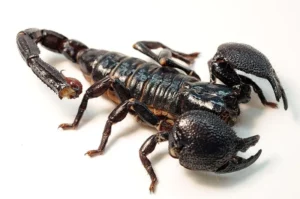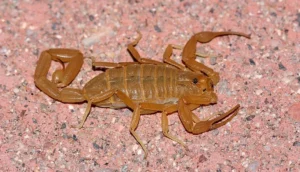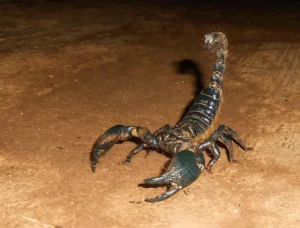Scorpions belong to Class Arachnids and are diversely distributed all over the world and especially inhabit desert ecosystems. Let us discuss a few common types of these widely-distributed predators here.
- Emperor Scorpion
- Deathstalker
- Arizona Bark scorpion
- Giant Hairy Scorpion
- Fattail Scorpion
- Brazilian Scorpion
- Heterometrus
- Indian Red scorpion
- Kolotl
- Nebo
- Giant Blue scorpion
- Stripe-tailed scorpion
- Hadogenes
- Small wood scorpions
- European yellow-tailed scorpions
Emperor scorpion
The most common group of scorpions is the Emperor Scorpions. They are widely distributed West Africa residing in burrows to adapt to the humid climate. They have black shiny bodies, four pairs of legs, pincers in front and a long arched tail at the back with venomous stingers at the tip of the tail. Emperor scorpions are nocturnal insects and use sensory receptors called pectens to navigate and detect prey.

Deathstalker
They are also called Palestine yellow scorpions and mostly dwell in arid deserts of Middle East, Central and South Asia and North Africa. Deathstalkers have high CO2 tolerance in their hemolymph and can survive in acidic pH to adapt to living in deserts. They are the most venomous species of scorpions found and their venom is composed of deadly neurotoxins like Chlorotoxin, Scyllatoxin.
Arizona Bark scorpion
As per their name, these scorpions are native to the Sonoran desert of Arizona, USA. It is found in rocks and crevices and has the unique ability to climb trees. They are extremely venomous noctornal predators and have long slender tail with pincers and a unique yellowish colored body.

Giant Hairy Scorpion
They are found all over the desert areas of America and are the largest in size, around four to seven inches. They are adapted to living in dessert burrows and feed on other small insects and spider and even larger lizards. Their venom is not that lethal but their body is covered all over with tiny hairs which help them to sense their prey.
Fattail Scorpion
These scorpions have a unique fat and curved ‘metasoma’ or tail and belong to the genus Androctonus. They are widely distributed across Africa and Middle-Eat and are extremely venomous capable of causing deaths. Apart from pincers they also possess claw-like structures attached to their mouth called chelicerae which helps them attack and tear apart their prey. These scorpions are also sold as exotic pets across the world.
Brazilian Scorpion
Tityus is the most common Brazilian scorpion found and is extremely venomous species. They are a growing cause of concern in Brazil because they have adapted to urban environment and females can even reproduce without fertilization. They are pale yellow in color and possess the venom sac at the tip of the tail with which they attack their prey.
Heterometrus
They are also called Giant Forrest scorpions distributed across tropical forests of Asia. The unique property of this type of scorpions is that their venom contains anti-microbial peptides. Gigantometrus swammerdami , found in India is the largest type of this species almost 23 cm long and 56 Kg in weight.

Indian Red scorpion
They are widely distributed in the Indian peninsula, Pakistan, Sri Lanka and Nepal. Their pincers and walking legs are bright yellowish-orange to reddish brown in color and very toxic venom causing 8-40% fatality. These scorpions belong to the Hottentota species and family Buthidae.
Kolotl
These type of scorpions belong to the Diplocentridae family and are mainly found in Mexico. They are fairly new species of scorpions discovered almost just a decade ago and consists of only two species, Kolot magnus and Kolotl poncei.
Nebo
They are also called Jericho or Common Black scorpion. This species also belongs to the family of Diplocentridae and is found in Central Asia and Egypt. They like dwelling in rocky dessert areas and have a brown body with yellowish legs. They have a thin tail called metasoma with oval stingers and are not as venomous as the other related species.
Giant Blue scorpion
Heterometrus spinifer or the Giant Blue Scorpion is almost twelve cm in length with a shiny black body that reflects greenish-grey color which gives its unique name. It is found in South-East Asia and have giant pincers to catch prey. They feed on larger insects like crickets and cockroaches and their venom is mildly toxic.
Stripe-tailed scorpion
This species is also called Devil Scorpion and normally dwell in southern America and Mexico. Their sizes are about 60 mm and have a thick tail with a yellowish golden glaze. The most unique feature of these scorpions is the brownish tan stripes at the back of its tail along the ridges. They have a unique mating ritual where the males and females dance and at the end the females eat the males and reproduce after 3-8 months giving birth to almost 100 offspring at a time.
Hadogenes
Hadogenes are found in Africa and have a flat body to help them live under rocks and crests in the desserts. They cannot travel across the sand and need to be sheltered. They also possess claws attached to the tarsus and which helps them with locomotion. Due to habitat loss they have been named as endangered species.
Small wood scorpions
They are called Euscorpius and are found in Africa, parts of Europe and Russia. They are not very venomous. They have dark brown body and yellowish brown legs and are adapted to warm climate, living in cracks of buildings, grass and hills. They are small in size and have powerful pincers.
European yellow-tailed scorpions
Tetratrichobothrius flavicaudis or European yellow-tailed scorpions are small in size with black body and distinct yellow brown legs. They are found in North Africa and Sothern Europe and are mildly venomous. They have strong claws and a thin tail and can thrive in urban areas like abandoned buildings and docks and sleepers. They are covered with tiny hairs which acts as a sensory organ and can live in cold climatic conditions.
Conclusion
There are more than fifteen hundred species of scorpions of which we discussed a few types in this article. They are widely found insects specially in deserts and forests and are quite predatory but are needed to be preserved because they play an important role in ecosystem.
Also Read:
- Do eukaryotes have a nucleus
- Biome examples
- Motile bacteria examples
- Dna splicing types
- Dispersive dna replication
- Are fungi heterotrophs
- Do proteins contain oxygen
- Exocytosis example
- Do bacteria have lysosomes
- Atp synthesis stages

Hi… I am Kaushani Misra, a Postgraduate in Biochemistry, and aspire to be an academic. Driven by curiosity and passion for science I enjoy learning new things and writing about them.